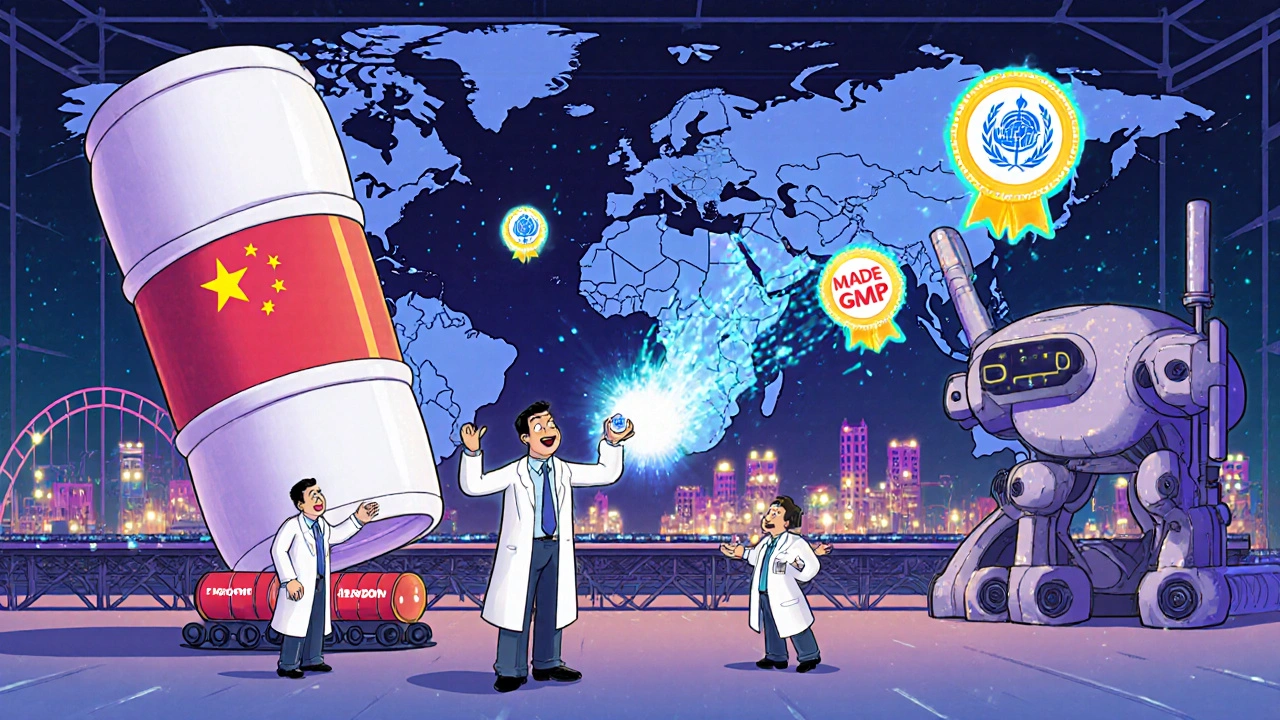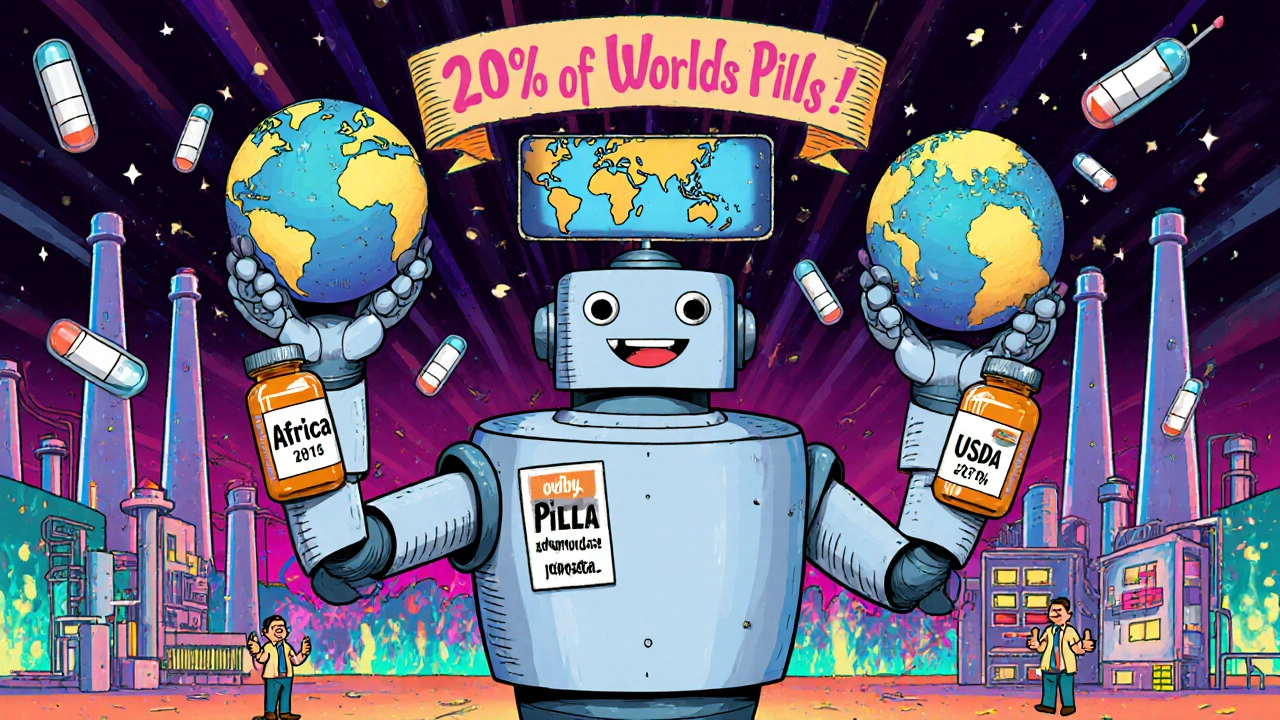When you take a pill for high blood pressure, an antibiotic, or even a vaccine, there’s a good chance it came from India. The country doesn’t just make medicines-it supplies the world. India is the largest producer of generic drugs by volume, sending out more than 20% of the world’s pharmaceuticals. That’s not a small number. It’s the difference between millions going without treatment and millions getting life-saving care at a price they can afford.
How India Became the Pharmacy of the World
It didn’t happen by accident. In the 1970s, India changed its patent laws. Instead of protecting drug formulas like other countries, it allowed local companies to copy patented medicines and make them cheaper. This wasn’t stealing-it was legal under international rules at the time. The goal was simple: make medicine affordable for Indians. But the side effect? A global revolution in drug access. By the 2000s, Indian manufacturers had perfected the art of making high-quality generics. They didn’t just copy pills. They learned how to make complex ones-extended-release tablets, injectables, patches-that even big U.S. and European companies struggled with. And they did it all at a fraction of the cost. A course of HIV medication that once cost $10,000 a year dropped to $100 thanks to Indian generics. That’s not marketing. That’s impact.Numbers That Speak Louder Than Words
By 2024, India’s pharmaceutical industry was worth $50 billion. It’s on track to hit $130 billion by 2030. But the real story is in the exports. India ships over 60,000 different generic medicines to more than 150 countries. It produces more than 60% of the world’s vaccines. That’s why organizations like Doctors Without Borders rely on Indian suppliers for antimalarials, antibiotics, and tuberculosis drugs. The U.S. gets 40% of its generic drugs from India. The UK gets a third of its generics from here. In Sub-Saharan Africa, nearly half of all medicines are Indian-made. These aren’t obscure brands. These are the same pills you find in pharmacies across America, Europe, and Africa-just without the brand name and the inflated price tag. India has over 650 factories approved by the U.S. Food and Drug Administration (FDA)-more than any other country outside the U.S. There are also over 2,000 facilities certified by the World Health Organization’s Good Manufacturing Practices (WHO-GMP). That’s not luck. It’s discipline. These factories don’t just meet standards-they often exceed them.Who’s Making the Pills?
It’s not just small players. The industry is led by giants:- Sun Pharma-India’s largest drugmaker, worth over $43 billion, with a focus on complex generics and dermatology drugs.
- Cipla-famous for bringing down HIV drug prices globally, now expanding into biosimilars and respiratory treatments.
- Dr. Reddy’s Laboratories-a global leader in injectables and oncology generics, with strong FDA compliance records.
- Biocon-pioneering biosimilars, which are cheaper versions of biologic drugs like those used for cancer and autoimmune diseases.

Why India Beats the Competition
China makes more active pharmaceutical ingredients (APIs)-the raw chemical building blocks of drugs. But China has only 153 FDA-approved factories. India has 650. That’s the difference between making the ingredient and making the actual medicine you swallow. European manufacturers like Teva and Sandoz make high-quality generics too, but they’re expensive. Their prices are often 2-3 times higher than Indian equivalents. That’s why public health systems in the U.S., UK, and Africa turn to India. Cost matters. But so does reliability. Indian manufacturers have improved dramatically over the past decade. In 2015, only 60% of Indian factories passed FDA inspections. Today, it’s 85-90%. That’s on par with global averages. The FDA now inspects Indian plants as often as U.S. ones. That’s not a coincidence-it’s a result of years of investment in quality control, documentation, and training.The Weak Spots
But India isn’t perfect. The biggest problem? Dependency on China for APIs. About 70% of the raw materials used in Indian drugs come from China. That’s risky. During the pandemic, supply chain disruptions caused shortages. The Indian government is trying to fix this with a $400 million incentive program to build domestic API plants. The goal? Self-sufficiency by 2026. Another issue? Value vs. volume. India makes a huge number of pills-but earns less money per pill. It supplies 30% of the U.S. generic market by volume, but only 10% by value. Why? Because Indian companies sell to price-sensitive buyers-governments, NGOs, and public health systems-not to premium brands. That’s a business model built on scale, not profit margins. There are also quality control gaps. A few bad batches have made headlines. In 2023, a Reddit thread detailed inconsistent absorption rates in a batch of Indian-made levothyroxine, a thyroid medication. Some users reported side effects. These cases are rare-less than 1% of exports-but they erode trust. Packaging inconsistencies and shipping delays also show up in customer reviews, especially on platforms like Trustpilot.What’s Next? Biosimilars and Beyond
The future isn’t in copying old drugs anymore. It’s in making new ones cheaper. Biosimilars-copies of complex biological drugs-are India’s next big play. In 2020, they made up just 3% of export value. Today, it’s 8%. By 2030, that number could hit 20%. Companies like Biocon are already exporting biosimilars for cancer, rheumatoid arthritis, and diabetes to Europe and the U.S. These drugs cost 30-50% less than the originals. That’s huge for patients who can’t afford $10,000-a-year treatments. India’s government has set a bold target: $190 billion in pharmaceutical exports by 2047. That’s ambitious. To get there, they need to fix API dependence, boost innovation, and raise compliance to 95%+. If they do, India won’t just be the pharmacy of the world. It’ll be the engine of global medical innovation.
What Patients Are Saying
In the U.S., 9 out of 10 prescriptions are for generics. Of those, 40% are Indian-made. On PharmacyChecker.com, 87% of users rate Indian generics as satisfactory-mainly because they’re affordable. In the UK, the NHS uses Indian generics in a third of prescriptions. Patient reviews average 4.2 out of 5. Complaints? Mostly about taste or packaging. Not effectiveness. In Africa, where out-of-pocket spending on medicine is high, Indian drugs are a lifeline. MSF reported that Indian-sourced antimalarials cut treatment costs by 65% while keeping 95% efficacy. That’s not just a savings. It’s a survival rate.Regulatory Hurdles and How They’re Being Overcome
Getting approved to sell in the U.S. or EU isn’t easy. It takes 3-5 years. One in three companies fail their first FDA inspection. Why? Poor documentation. Translation errors. Inconsistent testing. But things are changing. Today, 92% of Indian manufacturers use electronic common technical documents (eCTD)-the global standard for submitting drug applications. That’s up from just 40% in 2018. Training programs, government support, and pressure from buyers have pushed quality up. The new Schedule M guidelines, updated in early 2024, now require stricter controls on raw materials, equipment, and testing. The message is clear: if you want to export from India, you have to meet global standards. And most companies now know that.Are Indian generic drugs safe?
Yes, the vast majority are. Over 650 Indian manufacturing plants are approved by the U.S. FDA, and more than 2,000 meet WHO-GMP standards. Compliance rates have risen from 60% in 2015 to 85-90% today. While isolated quality issues have occurred, they represent less than 1% of total exports. Regulatory oversight has tightened significantly in the past decade.
Why are Indian generic drugs so much cheaper?
India eliminated product patents on drugs in the 1970s, allowing local companies to reverse-engineer and produce medicines without paying licensing fees. Combined with lower labor and operational costs, this allows Indian manufacturers to sell drugs at 30-80% less than branded versions. They focus on volume, not premium pricing.
Do Indian generics work as well as brand-name drugs?
Yes. To be approved, Indian generics must prove they are bioequivalent to the brand-name version-meaning they deliver the same amount of active ingredient at the same rate. Studies show they are just as effective. Differences in taste, color, or filler ingredients don’t affect how the drug works in your body.
Is India replacing China as the global drug supplier?
Not entirely, but it’s gaining ground. China makes more active pharmaceutical ingredients (APIs), but India leads in finished drug manufacturing. With 650 FDA-approved plants versus China’s 153, India is better positioned to supply ready-to-use medicines. The U.S. and EU are shifting orders to India for reliability and compliance reasons.
What’s the future of Indian generic drug manufacturing?
The future lies in moving up the value chain-from basic generics to complex drugs like biosimilars and inhalers. India is investing heavily in biotech and API self-sufficiency. By 2030, the goal is to reduce API imports from China from 70% to below 40%. If successful, India could become a global leader in affordable innovation, not just low-cost production.


So... India makes all the pills? Cool. But why do I still get weird side effects sometimes? Like, my thyroid med tastes like metal and my stomach hates it. I don’t care how cheap it is if I’m puking at 3am. 😩
Oh please. You’re telling me a country with corrupt hospitals and dirt roads makes better medicine than the U.S.? That’s the dumbest thing I’ve heard all week. If it’s so great, why don’t they just keep it for themselves? 🙄
India makes the meds I take. They work. I don’t care where they’re from. My blood pressure’s stable. That’s all that matters.
Y’ALL. I just want to say THANK YOU to the people in India who make these drugs 💖. My mom’s on a generic HIV med from India and she’s been alive for 15 years because of it. No brand name could’ve done that for our budget. It’s not just medicine-it’s dignity. 🙏❤️
As an Indian, I’m proud but also realistic. Yes, we make 60% of the world’s vaccines-but we still import 70% of our APIs from China. That’s like building a Ferrari but using stolen tires. The government’s pushing for self-reliance with $400M in incentives, but it’ll take more than money-it needs culture change. We need engineers who care about precision, not just speed. And yes, some batches fail. But 99%? Perfect. Let’s not throw the baby out with the bathwater. We’re not perfect… but we’re trying. 🇮🇳💪
Wait, so you’re saying a country with 1.4 billion people and zero sanitation standards makes safer drugs than the FDA? That’s a joke. You’re literally trusting your life to a factory that can’t even flush a toilet. And don’t even get me started on the ‘bioequivalent’ lies. I’ve seen the reports. The data’s fudged. You’re being manipulated.
I work in a rural clinic in Ohio. Our patients can’t afford $800 insulin. The Indian generics? $12. They work. The patients don’t care who made it-they care that they’re alive tomorrow. This isn’t about nationalism. It’s about humanity.
India? More like Indi-uh. And yeah, they make a lotta pills. But have you seen their packaging? My last script had a typo on the label. ‘Take 2x daily’… but it said ‘Tkae 2x daily’. Like, really? 😒
My cousin in Nairobi got malaria meds from India during the rainy season. She was out cold for 3 days. Then she woke up and danced in the street. Said the pills tasted weird but worked like magic. That’s the real story-not the stats. It’s people. It’s survival. It’s hope in a blister pack.
Let’s be real: India is a low-cost, low-quality, high-volume scam. They’re not innovating-they’re copying. And now they want to be seen as ‘global leaders’? Please. The FDA inspections are a circus. They pass because they bribe inspectors. The U.S. should ban all Indian generics tomorrow.